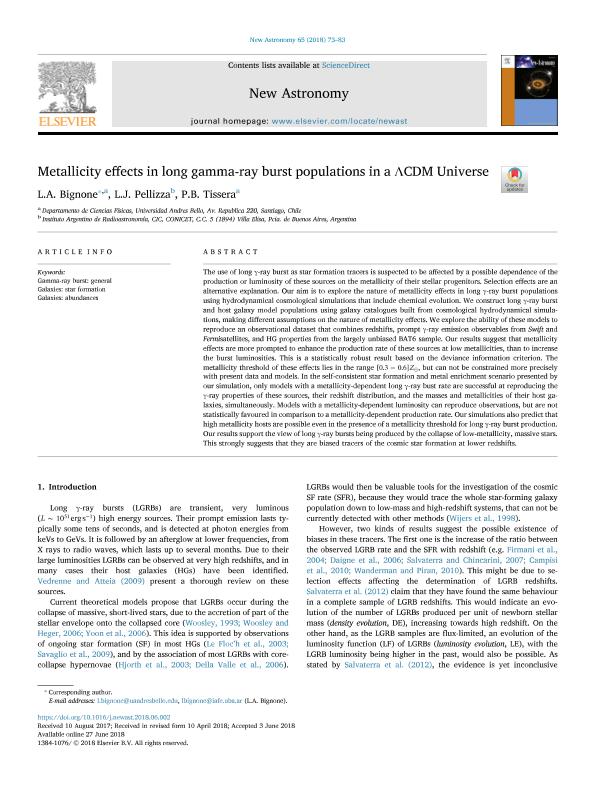Mostrar el registro sencillo del ítem
dc.contributor.author
Bignone, Lucas Axel

dc.contributor.author
Pellizza González, Leonardo Javier

dc.contributor.author
Tissera, Patricia Beatriz

dc.date.available
2019-09-09T13:17:37Z
dc.date.issued
2018-11
dc.identifier.citation
Bignone, Lucas Axel; Pellizza González, Leonardo Javier; Tissera, Patricia Beatriz; Metallicity effects in long gamma-ray burst populations in a ΛCDM Universe; Elsevier Science; New Astronomy; 65; 11-2018; 73-83
dc.identifier.issn
1384-1076
dc.identifier.uri
http://hdl.handle.net/11336/83100
dc.description.abstract
The use of long γ-ray burst as star formation tracers is suspected to be affected by a possible dependence of the production or luminosity of these sources on the metallicity of their stellar progenitors. Selection effects are an alternative explanation. Our aim is to explore the nature of metallicity effects in long γ-ray burst populations using hydrodynamical cosmological simulations that include chemical evolution. We construct long γ-ray burst and host galaxy model populations using galaxy catalogues built from cosmological hydrodynamical simulations, making different assumptions on the nature of metallicity effects. We explore the ability of these models to reproduce an observational dataset that combines redshifts, prompt γ-ray emission observables from Swift and Fermisatellites, and HG properties from the largely unbiased BAT6 sample. Our results suggest that metallicity effects are more prompted to enhance the production rate of these sources at low metallicities, than to increase the burst luminosities. This is a statistically robust result based on the deviance information criterion. The metallicity threshold of these effects lies in the range [0.3−0.6]Z⊙, but can not be constrained more precisely with present data and models. In the self-consistent star formation and metal enrichment scenario presented by our simulation, only models with a metallicity-dependent long γ-ray bust rate are successful at reproducing the γ-ray properties of these sources, their redshift distribution, and the masses and metallicities of their host galaxies, simultaneously. Models with a metallicity-dependent luminosity can reproduce observations, but are not statistically favoured in comparison to a metallicity-dependent production rate. Our simulations also predict that high metallicity hosts are possible even in the presence of a metallicity threshold for long γ-ray burst production. Our results support the view of long γ-ray bursts being produced by the collapse of low-metallicity, massive stars. This strongly suggests that they are biased tracers of the cosmic star formation at lower redshifts.
dc.format
application/pdf
dc.language.iso
eng
dc.publisher
Elsevier Science

dc.rights
info:eu-repo/semantics/openAccess
dc.rights
Atribución-NoComercial-CompartirIgual 2.5 Argentina (CC BY-NC-SA 2.5 AR)
dc.rights.uri
https://creativecommons.org/licenses/by-nc-sa/2.5/ar/
dc.subject
Galaxies: Abundances
dc.subject
Galaxies: Star Formation
dc.subject
Gamma-Ray Burst: General
dc.subject.classification
Astronomía

dc.subject.classification
Ciencias Físicas

dc.subject.classification
CIENCIAS NATURALES Y EXACTAS

dc.title
Metallicity effects in long gamma-ray burst populations in a ΛCDM Universe
dc.type
info:eu-repo/semantics/article
dc.type
info:ar-repo/semantics/artículo
dc.type
info:eu-repo/semantics/publishedVersion
dc.date.updated
2019-08-30T14:27:08Z
dc.journal.volume
65
dc.journal.pagination
73-83
dc.journal.pais
Países Bajos

dc.journal.ciudad
Amsterdam
dc.description.fil
Fil: Bignone, Lucas Axel. Universidad Andrés Bello; Chile
dc.description.fil
Fil: Pellizza González, Leonardo Javier. Provincia de Buenos Aires. Gobernación. Comisión de Investigaciones Científicas. Instituto Argentino de Radioastronomía. Consejo Nacional de Investigaciones Científicas y Técnicas. Centro Científico Tecnológico Conicet - La Plata. Instituto Argentino de Radioastronomía; Argentina
dc.description.fil
Fil: Tissera, Patricia Beatriz. Universidad Andrés Bello; Chile
dc.journal.title
New Astronomy

dc.relation.alternativeid
info:eu-repo/semantics/altIdentifier/doi/https://doi.org/10.1016/j.newast.2018.06.002
dc.relation.alternativeid
info:eu-repo/semantics/altIdentifier/url/https://www.sciencedirect.com/science/article/pii/S1384107617302592?via%3Dihub
Archivos asociados
